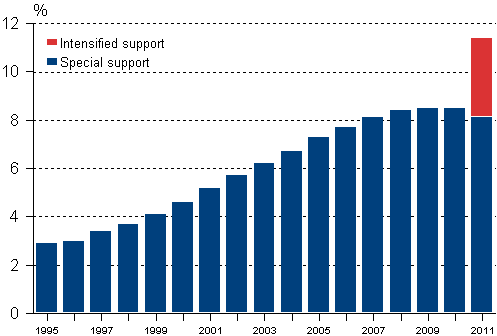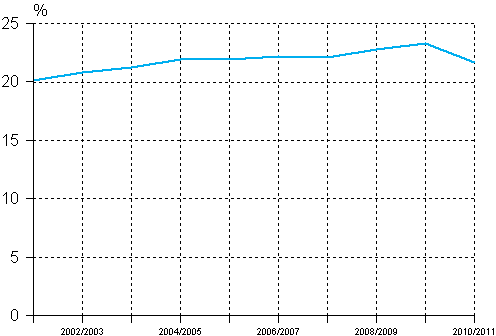Published: 12 June 2012
Intensified or special support was received by 11.4 per cent of comprehensive school pupils
Intensified support was received by 3.3 per cent and special support by 8.1 per cent of comprehensive school pupils in autumn 2011. One year earlier the share of pupils receiving special support was 8.5 per cent. The intensified support required by new legislation was organised for the first time in 2011. The receivers of intensified support most commonly received part-time special education and the receivers of special support special needs assistance and/or interpretation services. These data derive from Statistics Finland’s education statistics.
Share of comprehensive school pupils having received intensified or special support among all comprehensive school pupils 1995-2011, %

1) Pupils accepted or transferred to special education during 1995 to 2010 have been regarded as equal to pupils having received special support.
Seventy-seven per cent of the pupils who received intensified support received part-time special education, 55 per cent received remedial teaching and 40 per cent special needs assistance and/or interpretation services. Thirty-four per cent of the pupils who received special support received part-time special education, 30 per cent received remedial teaching and 47 per cent special needs assistance and/or interpretation services.
Among the recipients of intensified support, 65 per cent were boys and 35 per cent girls. Among the recipients of special support, 69 per cent were boys and 31 per cent girls. Twenty-six per cent of the pupils receiving special support had extended duration of compulsory education.
The share of recipients of intensified support among all pupils was highest in Ostrobothnia at over 5 per cent. On Mainland Finland their share was lowest in Central Ostrobothnia at 2 per cent. No intensified support was organised in Åland. The share of recipients of special support was highest in the region of Päijät-Häme, where it was nearly 11 per cent. On Mainland Finland, the ratio of recipients of special support to the total number of pupils was lowest in North Ostrbothnia at under 6 per cent. In Åland, 4 per cent of pupils had received special support.
Twenty-one per cent of the recipients of special support had been fully integrated into general education groups and 18 per cent received more than half (51-99%) of their teaching in a general education group. The remaining 61 per cent of the pupils with special support received at least half of their teaching in a special group. Of this, the share of recipients of all teaching in a special group was 42 per cent.
Forty-four per cent of the pupils having received special support on grades 1 to 9 and during additional education of the comprehensive school studied general education syllabuses in all subjects. Fourteen per cent of the pupils had individualised syllabuses for one subject, 12 per cent for two to three subjects and 25 per cent for four or more subjects. Five per cent of the pupils receiving special support studied according to functional skill areas. The teaching can be arranged according to functional skill areas if it cannot be arranged by subject syllabuses due to the pupil's severe disability or illness.
In the academic year preceding the aforementioned data, i.e. 2010/2011, altogether 21.7 per cent of comprehensive school pupils, or 118,400 pupils, received part-time special education. With some of them the part-time special education was included in special support. The share of comprehensive school pupils having attended part-time special education diminished by 1.6 percentage points from the previous academic year. Expressed in numbers the reduction from the previous academic year was 10,200 pupils.
Share of comprehensive school pupils having received part-time special education among all comprehensive school pupils in academic years 2001/2002 to 2010/2011

During 2010, a total of 19,300 students in vocational education leading to a qualification received special education. The number was 1,100 higher than in the year before. The share of special education students was 6.9 per cent among all students and 13.8 per cent among students attending vocational education aimed at young persons (curriculum-based basic vocational education provided by educational institutions).
The share of men among the students of special vocational education was 59 per cent. Thirteen per cent of the special education students attended special vocational education institutions and 10 per cent studied in special groups of other institutions providing vocational education. The share of students who studied in same groups as other students (were integrated) was 77 per cent. Nearly one-half of the special vocational education students studied in the field of technology and transport.
Source: Education. Statistics Finland
Inquiries: Riikka Rautanen 09 1734 2375, koulutustilastot@stat.fi
Director in charge: Jari Tarkoma
Publication in pdf-format (265.6 kB)
- Tables
-
Tables in databases
Pick the data you need into tables, view the data as graphs, or download the data for your use.
Appendix tables
- Appendix table 1. Comprehensive school pupils having received intensified or special support, 2011 (12.6.2012)
- Appendix table 2. Part-time special education, remedial teaching, and special needs assistance and interpretation services received by comprehensive school pupils having received intensified or special support, 2011 1) (12.6.2012)
- Apprendix table 3. Comprehensive school puplis having received special support by duration of compulsory education, 2011 (12.6.2012)
- Appendix table 4. Comprehensive school pupils having received special support by place of provision of teaching, 2011 (12.6.2012)
- Appendix table 5. Pupils having received special support on grades 1-9 and during additional education of comprehensive school by subject syllabus, 2011 (12.6.2012)
- Appendix table 6. Comprehensive school pupils having received special support, 1995-2011 1) (12.6.2012)
- Appendix table 7. Comprehensive school pupils having received part-time special education from academic year 2001/2002 to academic year 2010/2011 1) (12.6.2012)
- Appendix table 8. Students of special vocational education by place of provision of teaching, 2004-2010 (12.6.2012)
Updated 12.6.2012
Official Statistics of Finland (OSF):
Support for learning [e-publication].
ISSN=1799-1617. 2011. Helsinki: Statistics Finland [referred: 5.1.2026].
Access method: http://stat.fi/til/erop/2011/erop_2011_2012-06-12_tie_001_en.html

